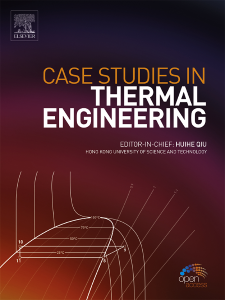Analysis of the interaction between airflow and high-voltage electric fields on drying characteristics of carrots using heat pump-electrohydrodynamics combined drying
IF 6.4
2区 工程技术
Q1 THERMODYNAMICS
引用次数: 0
Abstract
The study investigates the drying characteristics of carrots under different coupling forms of airflow and high-voltage electric fields (parallel flow, PF, and cross flow, CF) using heat pump-electrohydrodynamics (EHD) combined drying. The results show that, compared to single heat pump drying, the combined drying under PF mode reduces carrot drying time by 13.33 %–31.58 %, increases effective moisture diffusivity (Deff) by 17.80 %–32.32 %, increases specific moisture extraction rate (SMER) by 12.25 %–34.26 %. While the combined drying under CF mode reduces carrot drying time by 12.5 %–18.18 %, increases Deff by 7.27 %–13.14 %, increases SMER by 4.64 %–12.58 %. The improvements in parameters under the CF mode are weaker than those under the PF mode. Additionally, the β-carotene content under PF mode is consistently higher than under CF mode. Based on the experimental results, the Modified Page model was improved, yielding an updated model MR = aexp(-(kt)^n), with an R2 value of up to 0.9999–1, which provides theoretical guidance for optimizing the heat pump-EHD combined drying process.
利用热泵-电流体动力联合干燥法分析气流和高压电场对胡萝卜干燥特性的相互作用
该研究利用热泵-电动流体力学(EHD)联合干燥技术,研究了气流和高压电场(平行流,PF;交叉流,CF)不同耦合形式下胡萝卜的干燥特性。结果表明,与单一热泵干燥相比,PF 模式下的组合干燥可缩短胡萝卜干燥时间 13.33 %-31.58%,提高有效水分扩散率 (Deff) 17.80 %-32.32%,提高比水分提取率 (SMER) 12.25 %-34.26%。而在 CF 模式下进行组合干燥,胡萝卜干燥时间缩短了 12.5 %-18.18 %,Deff 增加了 7.27 %-13.14 %,SMER 增加了 4.64 %-12.58 %。与 PF 模式相比,CF 模式对参数的改善较弱。此外,PF 模式下的β-胡萝卜素含量一直高于 CF 模式。根据实验结果,对修正佩奇模型进行了改进,得到了最新模型 MR = aexp(-(kt)^n),R2 值高达 0.9999-1,为优化热泵-EHD 联合干燥工艺提供了理论指导。
本文章由计算机程序翻译,如有差异,请以英文原文为准。
求助全文
约1分钟内获得全文
求助全文
来源期刊

Case Studies in Thermal Engineering
Chemical Engineering-Fluid Flow and Transfer Processes
CiteScore
8.60
自引率
11.80%
发文量
812
审稿时长
76 days
期刊介绍:
Case Studies in Thermal Engineering provides a forum for the rapid publication of short, structured Case Studies in Thermal Engineering and related Short Communications. It provides an essential compendium of case studies for researchers and practitioners in the field of thermal engineering and others who are interested in aspects of thermal engineering cases that could affect other engineering processes. The journal not only publishes new and novel case studies, but also provides a forum for the publication of high quality descriptions of classic thermal engineering problems. The scope of the journal includes case studies of thermal engineering problems in components, devices and systems using existing experimental and numerical techniques in the areas of mechanical, aerospace, chemical, medical, thermal management for electronics, heat exchangers, regeneration, solar thermal energy, thermal storage, building energy conservation, and power generation. Case studies of thermal problems in other areas will also be considered.
 求助内容:
求助内容: 应助结果提醒方式:
应助结果提醒方式:


